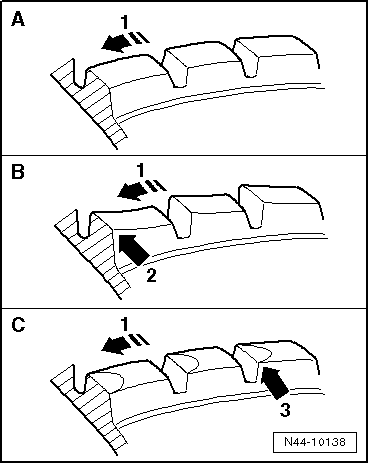| A - | Tread block of a new tyre; seen in direction of motion -arrow 1-, tread blocks are equally high in front and back. |
| B - | Development of saw teeth; seen in the direction of rotation -arrow 1-, tread blocks are higher in front -arrow 2- than in back. |
| C - | Seen in the direction of rotation -arrow 1-, tread blocks show greater wear in the front section of the „saw tooth“-arrow 3-. |
| Pronounced saw-tooth wear can lead to customers complaining about tyre noise. |
| Pronounced saw-tooth wear occurs under the following conditions: |
| t
| toe values are too high |
| t
| tyre pressures are incorrect |
| t
| tread is coarse and open |
| t
| tyres are fitted on the non-driven axle |
| In the event of saw-tooth wear, the direction of rotation of the tyre must be reversed. If saw-tooth wear is especially pronounced and tyre noise has increased, interchange the tyres diagonally. This will reduce the saw-tooth effect. |
| On front-wheel-drive vehicles, this effect is intensified by the greater wear on the front axle. |
| Tyre noise will be somewhat louder immediately after the tyres have been interchanged but will return to a normal level after about 500…1,000 km have been driven. |
| In the event of increased saw-tooth wear on the rear tyres – in particular on front-wheel drive vehicles – interchange the front and rear tyres. In the event of increased saw-tooth wear on the outer edges of the tyres on one axle, turn both tyres around on their rims. The left-hand wheel must then be fitted on the right side of the vehicle and the right-hand wheel on the left side. |
|
|

|